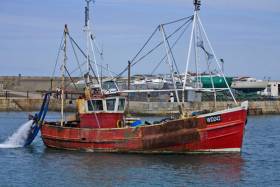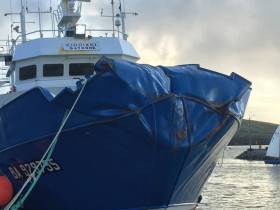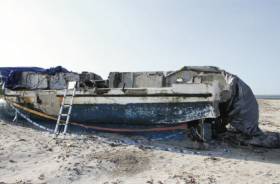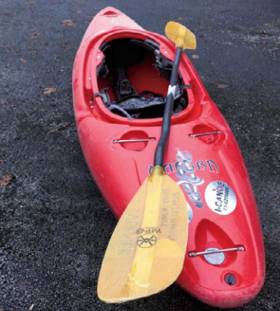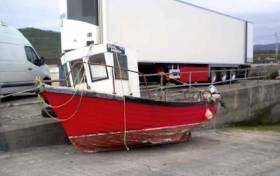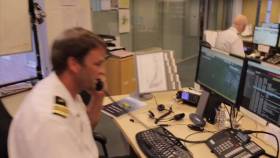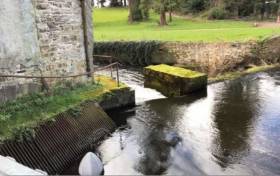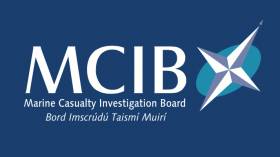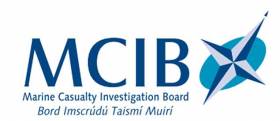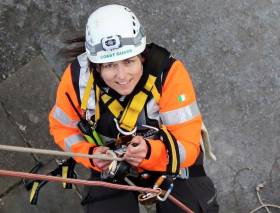Displaying items by tag: MCIB
Current & Future Guidelines For Fishing Vessel Safety
In response to Marine Casualty Investigation Board (MCIB) recommendations, the Department of Transport, Tourism and Sport (DTTAS) has issued a Marine Notice to remind masters, owners, users, charterers, skippers and crew of fishing vessels of previous safety advice and requirements.
In addition, the notice informs the sector of several recommendations in relation to smaller vessels that are under consideration for inclusion in the next revision of the Code of Practice for the Design, Construction, Equipment and Operation of Small Fishing of less than 15m in Length overall.
In recent years the MCIB has made several recommendations some of which were incorporated in the most recent revision of the Code of Practice, most notably in relation to a requirement for all such fishing vessels to carry an automatic, float-free Emergency Position-Indicating Radio Beacon (EPIRB) and for all fishers to carry Personal Locator Beacons (PLBs).
Some recommendations required further consideration and additional recommendations have since been made including:
- Improvement of stability standards (including freeboard and freeing ports in small decked vessels);
- Consideration of stating a minimum height of rails/bulwarks;
- A mandatory requirement for fishing vessels to be fitted with smoke/fire detection systems in engine rooms and for fuel and hydraulic oil pipes to be constructed out of fire resistant material;
- A requirement to carry safety harnesses for each person on board; and
- Making mandatory the holding of emergency drills for vessels less than 12 metres.
Owners are reminded that the nature and extent of any major repairs or major structural modifications to their vessel must comply with the Code of Practice for the Design, Construction, Equipment and Operation of Small Fishing Vessels of less than 15m Length overall (Section 1.5.4.4)
A reminder of previous relevant Marine Notices pertaining to fishing vessel safety is included in Marine Notice No 49 of 2019, a PDF of which is available to read or download HERE.
Investigation into Collision off Kerry Coast Last Weekend
The Marine Casualty Investigation Board has confirmed that it is liaising with several flag states over a collision off the Kerry coast last weekend writes Lorna Siggins
One fisherman was injured in the massive impact, which smashed in the bow of the 37m (121 ft) French vessel, Kirrixki when it collided with a 229m (751ft) cargo ship.
The incident occurred shortly after 1 am on Saturday, October 12th, some 37 nautical miles north-west of Valentia island.
Valentia Coast Guard tasked the RNLI Valentia all-weather lifeboat after it was notified of a collision at sea, with no further details at the time.
Fortunately, the smaller vessel was still afloat, but one of nine crew on board had sustained suspected spinal injuries.
The cargo ship was a Chinese bulk carrier named Hua Sheng Hai, en route to Aughinish Alumina in the Shannon estuary from Guinea.
South-west winds were force three to four at the time, with a four-metre swell, and it was considered too risky to attempt a boarding.
A decision was taken to escort the Kirrixki into Dingle harbour, where the injured man was immobilised and transferred to an ambulance.
RNLI Valentia lifeboat spokeswoman Shelly Curran said that the combination of swell and the nature of the injuries was such that it was felt safer to keep the injured man on the fishing vessel.
“We kept in contact with the crew at all times when them in,” Ms Curran explained.
The injured man was taken to University Hospital Kerry by National Ambulance Service personnel for further medical attention.
Valentia lifeboat coxswain Richard Quigley, who was at sea with his volunteer crew for seven hours, said the fishing vessel “made the right decision in calling for help to ensure the casualty received the proper medical treatment”.
The MCIB said this week it is “liaising with French and Hong Kong authorities” in relation to investigating the circumstances,
The Department of Transport said that it understood that the collision occurred outside of Irish waters, and there were no Irish-flagged vessels involved.
It confirmed that the matter “falls to the respective flag states” under international maritime law.
The Kirrixki, which is registered in Bayonne, south-west France, remained in Dingle harbour at the weekend.
Small Boat Fishermen Reminded Of Requirements After MCIB Reports Into Fatal Incidents
New Marine Notices from the Department of Transport, Tourism and Sport (DTTAS) remind skippers and crew of small fishing vessels of the requirements set out in the relevant Code of Practice, following the official maritime reports into two fatal incidents off the West Coast last year.
Marine Notice No 38 of 2019 has been published in response to a fatal fishing boat capsize off Co Mayo in the spring of 2018, as previously reported on Afloat.ie.
One man died and two others were recovered some 16 miles off Eagle Island after their vessel, the FV Aisling Patrick, overturned on the afternoon of 10 April last year.
The report from the Marine Casualty Investigation Board (MCIB) clarifies that their vessel had begun to list to starboard and while that was being investigated, a wave struck from the port side and flooded the deck.
Before the skipper could complete a Mayday call, a second wave came from the port side that capsized the boat.
Only one of the three made it into the vessel’s liferaft, while the deceased “was in the water face down and did not make any attempt to swim or stay afloat”.
The upturned hull of the vessel drifted away but was reported off South Uist in Scotland some three weeks after the incident and later inspected.
While the MCIB report did not determine conclusively the cause of the capsize, it was noted that the vessel’s stability was affected due to water ingress — possibly from suboptimal pipe connections — and that the bilge alarm system did not give early warning to the skipper or crew.
Among other findings, it was noted that none of the three men on board was wearing a personal flotation device (PFD), and that the deceased — who had been returning to fishing after a number of years away — had not completed necessary training.
The Marine Notice reminds owners that any major repairs or modifications must comply with the Code of Practice (CoP), and that their vessel must be maintained and operated in accordance with its requirements.
A second Marine Notice, No 39 of 2019, pertains to the investigation into the sinking of a small boat while laying lobster pots off Connemara on 23 May 2018.
As reported here by Lorna Siggins earlier this month, the MCIB found that the boat’s owner, who died in the incident, had purchased a substantial amount of safety equipment — almost none of which was on board at the time.
The notice refers to the same CoP as well as to the advisory published this summer relating to the safety of small vessels engaged in pot fishing.
Lack of Communication Delayed Alerting Emergency Services When Kayaker Trapped in Kerry River, MCIB Report States
An inquiry into the death of an experienced kayaker on a Kerry river last year has found that the lack of communication at the scene delayed call to the emergency services writes Lorna Siggins
Brita Waters (36) from Baldoyle, Dublin, drowned after she became trapped under a log on the Roughty river in Kilgarvan on November 4th, 2018.
The Marine Casualty Investigation Board (MCIB) report says that not all of the requirements of a code of practice for recreational craft were adhered to, including carrying personal locator beacons (PLBs) on remote rivers with grade 3 or “difficult” conditions.
The one mobile phone with the group was in the pocket of Ms Water’s lifejacket.
It says that a lack of any other mobile phone or other means of contact at the scene of the incident resulted in a 37-minute delay in calling the emergency services.
Ms Waters, who lived in Douglas, Cork, but had family connections with Baldoyle in Dublin and Dungarvan, Co Waterford, was a social studies graduate who had worked with Tusla, the child and family agency.
She was a highly experienced member of the Lir Canoe Club and had provided training and safety cover for fellow kayakers on events such as the Liffey Descent.
She had volunteered abroad and at home with Alone, the charity for vulnerable older people, and with Make-A-Wish, which organises events for children and teenagers with life-threatening medical conditions.
The incident occurred when Ms Waters was one of a group of five from her club, navigating the Roughty, a 30km river running via Kilgarvan, Co Kerry, into Kenmare Bay.
The MCIB report confirms that all of the group were adequately trained and experienced, and the group was familiar with the river, which is classed as 3-4 white water grading, suitable for mixed ability groups.
They had inspected the river and were aware of a log obstruction on the route, but had planned to exit before this.
Ms Waters had started to turn into a side channel when her kayak was capsized by an underwater rock. She slipped out and was unable to grab the handles of the kayak or get onto her feet.
“She was washed quickly downriver over the drop obstructed by a large log and was trapped by the water flow under the log. The distance between the point of capsize and the drop was between five and six meters,” the report states.
Had the log not caught the casualty, and the water flow around it pushed her down, she would have arrived safely at the pool below the drop,” the MCIB report states.
The report says all four kayakers tried to pull her free, but the water flow was pushing her down. They tied ropes to try and keep her head above water, and tried to move the log but were unable to do so.
After about 20 minutes, one of the group went up to the road about 200 metres away and called the emergency services with a passer-by’s phone. The Kenmare Fire Brigade was first on the scene, followed by the Garda.
Rescue efforts focused on trying to move the log, which took just over an hour, but it was then found that Ms Waters was being trapped by a second more dangerous log with branches underneath.
Her buoyancy vest was cut away and she was released at 13.55 hours. She was pronounced dead by a doctor attending with the ambulance service after she was brought ashore.
A post mortem concluded death was caused by acute cardio-respiratory failure due to drowning.
The MCIB report says that “kayaking groups making descents on remote rivers of Grade 3 and higher should carry registered PLBs”.
It recommends that the requirements set out in Chapter 7 of the code of practice for recreational craft for canoeing/kayaking “should be highlighted by means of a Marine Notice”.
MCIB Report Warns of Danger of Modifying Vessels & Changing Engines Without Proper Evaluation
An investigation into the death of a man in a small boat sinking off Connemara last year has found that he had purchased substantial safety equipment, almost none of which was on board at the time of the fatal incident writes Lorna Siggins
The only safety equipment on board was a life ring of a “non-approved type” which could not float free when the 16.5m open boat began taking in water, according to the Marine Casualty Investigation Board.
The incident involved a 6.5m (21) ft glass-reinforced plastic (GRP) open boat named Béal Sruthán which was laying lobster pots off Craugh island, west of Omey, on May 23rd, 2018.
The boat owner, Vincent Leggett (62) of Coolacloy, Clifden, Co Galway, was using the vessel for the first time since it had been modified and was on his third run of the day to set lobster pots from a pier near Coolacloy..
Weather conditions were good at the time with light variable winds, and the owner was alone, and was not wearing a personal flotation device on the working deck.
The owner had undergone Bord Iascaigh Mhara (BIM) basic safety training in April 2015, and was approved for grants to buy equipment through the BIM fleet safety scheme.
Equipment purchased included a PFD with an inbuilt personal locator beacon, an emergency position indicating radio beacon, a number of flares, smoke signals, first aid kit and fire extinguishers, along with a VHF transceiver and an approved lifebuoy with a 30-metre safety line.
The alarm was raised in the late afternoon of May 23rd, 2018 when Mr Leggett rang a friend by mobile phone to say the vessel was taking in water. The contact onshore alerted the emergency services but was unable to reach Mr Leggett again by phone.
The RNLI Clifden lifeboat, and Irish Coast Guard helicopter were tasked, and the emergency services were on the scene in approximately 25 minutes.
The initial search area was given as the south-west corner of Craugh island west of Omey, but there was nothing to be seen when the RNLI arrived.
The casualty was located lying in the water by the Irish Coast Guard helicopter which directed the RNLI vessel to the location, north east of where it was. The casualty was not wearing a PFD when recovered from the water, the report states.
The report notes that there was no formal communication to a responsible person onshore as to the time of departure and expected time of return, and the vessel did not make a VHF radio call or operate a locator beacon.
The report states that the boat was bought second-hand in late 2017 and worked on over the winter period in preparation for the 2018 season.
One modification undertaken was the removal of the inboard diesel engine that was installed, cropping the transom and mounting a Yamaha 50 hp outboard motor on the transom.
The MCIB report says the boat was not inspected or measured before the incident and was not examined under the State’s code of practice for the design, construction, equipment and operation of small fishing vessels of less than 15 m length overall.
The report states the modifications made to the vessel should only have been carried out in consultation with a naval architect and notes the weight of the inboard engine, located amidships in the cockpit area was transferred to the transom.
The MCIB says it was unclear as to whether the vessel was engaged in commercial or recreational fishing, but should have complied with requirements of the code of practice for either type of vessel. It says the vessel did not have a declaration of compliance or a licence to engage in commercial fishing.
The report recommendations include issuing a marine notice on safety of small fishing vessels engaged in potting operations, and a reminder of the dangers associated with modifying vessels, including changing an engine without proper evaluation.
Shane Ross, the Minister for Transport, Tourism and Sport has published a new National Search and Rescue Plan aimed at placing Ireland at the forefront of international best practice.
The plan also addresses some key lessons arising from tragic accidents involving Search and Rescue services in Ireland over the last three years. The new plan replaces the existing National Maritime SAR Framework dating from 2010. It will be the baseline guide for all Search and Rescue (SAR) organisations in Ireland. It underpins agreed methods of coordinating and conducting all SAR activities in Ireland and provides for a robust governance and oversight regime for SAR into the future.
Minister Ross said: “This review and the resulting National SAR Plan is about significantly improving the manner in which the State provides and oversees Search and Rescue. Ultimately, our objective is to make our SAR service better and safer for all those involved and ensure that we have clear guidelines and practice for those who have vital roles and responsibilities to fulfil.”
The Minister continued: “This new plan takes account of the recommendations arising from a succession of Reports and Reviews in relation to Search and Rescue in Ireland over the last year, including the AAIU’s Interim Statement (March 2018), the AQE Report on a “Review of Oversight of Search and Rescue (SAR) Aviation Operations in Ireland” (September 2018) and the Marine Casualty Investigation Board Report (MCIB) into the fatal accident in Kilkee involving a Coast Guard volunteer (December 2018).”
He said: “It is vital that we learn the lessons from tragic accidents such as Kilkee and Blacksod and that we nurture and promote a world class Search and Rescue service.”
A key conclusion of the SAR review, which underpins the new National SAR Plan (NSP), is that roles, responsibilities and inter-dependencies within the overall SAR system need to be clear, explicit and understood by all those concerned. A new Governance and Oversight chapter in the plan sets out these roles very clearly, from strategic, tactical through to operational levels. It also recommends SAR stakeholders meet at least annually to review the plan.
The NSP delivers on a new mechanism of assurance in relation to standards and practices and oversight of the overall SAR system. This will include the creation of a support network to assist those involved in search and rescue to develop minimum standards and practices and to embed principles of continuous improvement and safety within their organisations. It also creates a new SAR Regulators’ Forum, a unique initiative which brings transport regulators in the Search and Rescue domain together to exchange good practice and seek to improve the overall system assurance mechanisms.
A new National SAR Committee has been created with renewed terms of reference which underpins its role in providing strategic coordination, guidance and leadership for Search and Rescue. This group will monitor the performance and adequacy of the SAR system and advise on any necessary improvements. It will be chaired by Sir Alan Massey – ex CEO of the UK’s Maritime and Coastguard Agency. Its members will include senior representatives from the Coast Guard (IRCG), Irish Aviation Authority (IAA) and An Garda Síochána (AGS), their parent Departments and other strategic partners in both the State (Departments of Defence, Health and Local Government) and the voluntary SAR sector (RNLI).
The SAR Review report also includes an implementation plan for a new “virtual” Joint Rescue Coordination Centre (JRCC) model. This was another key recommendation in the AQE Report. The new model will secure additional collaboration between the Aviation Rescue Coordination Centre (ARCC), which is managed by the IAA, and Marine Rescue Coordination Centre (MRCC), which is managed by the Coast Guard. This will greatly enhance the overall SAR system. Utilising enhanced technologies and greater collaboration, the new JRCC will capitalise on the strengths of the current Aeronautical RCC and Maritime RCCs and ensure a more coherent response.
With regard to Marine Casualty Investigation Board (MCIB) recommendations included in the review process, the new Search and Rescue Plan acknowledges the on-going work of the Irish Coast Guard (IRCG) in developing an accredited safety management system. The IRCG’s new Standard Operating Procedures and guidance material relevant to the MCIB report were subject to international peer review (involving Canada, New Zealand and Sweden) and are being modified to reflect best practice in relation to boat launching and the transition from search and rescue to search and recovery phase of IRCG operations.
In conclusion, Minister Ross said: “I would like to convey my thanks to those Departments and agencies who participated in the review process. I would particularly like to thanks Sir Alan Massey for his leadership and expertise through this seven month review process. I am very pleased with what has been achieved in such an ambitious timeframe since the publication of the AQE Report. We must now endeavour to build on this momentum and the ambition in this report which is to make Ireland’s SAR service “best in class” internationally – and in doing so, honour the memory of those who have lost their lives in the service of others.”
The State’s Marine Casualty Investigation Board (MCIB) has been unable to identify the precise circumstances which led to the death of an experienced canoeist on the river Suir in Cahir, Co Tipperary in November, 2017 writes Lorna Siggins.
However, next of kin and a witness to the incident have taken issue with several key aspects of the MCIB report, published on Wednesday.
The canoeist, who was a medal-winning slalom competitor, drowned after he capsized below a weir close to Cahir Castle while leading a group of paddlers.
The 185km-long river Suir rises just north of Templemore, Co Tipperary passes through Cahir, Clonmel and Carrick on Suir, Co Waterford.
 The canoe that capsized Photo: MCIB
The canoe that capsized Photo: MCIB
After he capsized, the canoeist was initially seen not to be in any difficulty but disappeared out of sight around a bend.
The MCIB report concludes that was unable to rescue himself and floated over 4 km downriver before he was recovered by emergency services.
The canoeist had been equipped with a buoyancy aid during the expedition, but was not wearing it when recovered from the water, and did not respond to first aid.
The incident occurred after a group of 12 kayakers, varying in age from nine years to 67 years and of different skill qualifications, left the town mall slip in Cahir at about 10.30 am on November 11th, 2017.
“Some of the group had their own kayaks and safety equipment and others had kayaks and safety equipment provided by the adventure organisation set up by the casualty and a partner,” the report states.
The group split in two, and one group of four planned to navigate a weir on the western side of the Suir’s main channel, and then join the others.
“As the group of four approached the weir the casualty, the most experienced member of the group, gave verbal instructions as to how best to navigate the weir. He stated he would go first and be followed by the two teenagers and the man following last,” the report states.
The canoeist, described by the MCIB as a level 2 trainee kayak instructor, capsized and surfaced on the right-hand side of the river.
“ He was seen standing facing against the wall on the western downriver side of the weir and making his way downstream,” the report states.
“ He did not appear to be in any difficulty. He did not acknowledge or communicate in any way with the three remaining kayakers. He quickly went out of sight of remaining kayakers due to a bend in the tributary,”it states.
“The person was unable to rescue himself and get to safety and floated approximately 4.18 km down the River Suir where rescue services recovered him from the water. He did not respond to first aid,” it says.
The canoeist had been wearing his buoyancy aid prior to shooting the weir, and the MCIB concludes it was either “removed by the casualty or lost between the time of the incident and the time of the recovery”.
It notes that the buoyancy aids “ may be suitable in instances where the wearers remain capable of helping themselves” but “ should not be used in rough conditions or when there is wave splash”.
The report does note that this is “the standard buoyancy aid used for kayaking in Ireland”.
The canoeist was spotted at 11.30am by a passerby, and the Irish Coast Guard Waterford-based helicopter was tasked at 11.33am and Garda at Cahir was informed.
However, due to poor visibility, the helicopter had to request permission to stand down at 12.31
A local fire brigade unit tried to reach the casualty without success, and he was recovered at 12.38 from a location near Garnavilla House with the help of Suir River Rescue.
Next of kin of the canoeist, along with a witness, have taken issue with several aspects of the MCIB report, as outlined in correspondence published with the document.
The report states that there was “no documented record of a risk analysis of the potential dangers prior to setting out on the course over the weir” as per the code of practice for the safe operation of recreational craft.
The MCIB report also concludes that the canoeist’s adventure organisation was not affiliated to Canoeing Ireland – which, it acknowledges, is not a legal requirement.
Canoeing Ireland oversees training and qualification standards for the sport. Canoeing Clubs are affiliated to and regulated by the Irish Canoe Union.
“This is misleading as the members of the organisation were members of Canoe Ireland and were trained through Canoeing Ireland,” next of kin correspondence, which is included in the report’s appendices, states.
“ The members of the adventure club abided by the rules of Canoeing Ireland, so it is misleading and hinting that the association was less than official. They had applied for membership and were waiting for reply,” the correspondence says.
A witness also attests to the canoeist’s experience and to his membership of Canoeing Ireland and notes that the canoeist and other members of the club ran the sluice weir regularly and were very familiar with it in a variety of conditions.
In relation to a documented risk analysis, the next of kin correspondence also states that “the course had been studied for hidden dangers, snags, currents, etc before the boat was put on the water” and there was “also a plan of action on who would go in which order and how to go down”.
“ I do wonder where it says this risk analysis needs to be documented in writing and how many different passages and waterways are risk assessed in this way if it actually is required,”the next of kin correspondence says.
“This passage and river were well travelled by this group and this group was quite experienced. The risks had been assessed previously,”it says, and observes the MCIB seems to be “picking on a documentation issue”.
The next of kin correspondence says that the report “draws a strange and problematic conclusion”.
“I honestly cannot identify anything from this report that is useful or sheds some light on the situation or what would have helped avoid the situation,” the correspondence states.
The MCIB report, which did include amendments, “notes” the points raised in the correspondence.
It recommends that the Minister for Transport, Tourism and Sport issue a marine notice reminding kayakers, kayaking and canoeing organisations of obligations to comply with the code of practice for safe operation recreational craft and the relevant chapter dealing with canoeing/kayaking.
The full report can be downloaded here
A new bill before the Dáil seeks to amend the “bizarre circumstances” that mean there is no legal obligation for members of the Marine Casualty Investigation Board (MCIB) to have relevant marine accident experience.
As TheJournal.ie reports, the Merchant Shipping (Investigation of Marine Casualties) Amendment Bill 2019 tabled by Mattie McGrath TD has been welcomed by relatives of two men who drowned off Helvick Head in May 2010.
The families of John O’Brien and Patrick Esmonde have taken issue with the standard of the MCIB investigation into their deaths.
The MCIB report published in February 2012, which called for better safety awareness among leisure boat users, did not conclude exactly how the pair came to enter the water. An inquest into the tragedy more than 18 months later returned an open verdict.
McGrath, who says he has “worked closely with John O’Brien’s sister Anne-Marie” on the proposed legislation, claims that the lack of a legal mandate for MCIB investigators to have relevant accident experience “has always been a major issue for the two families, who have never accepted the official outcome of the investigation into the deaths on the summer’s day”.
TheJournal.ie has much more on the story HERE.
Marine Casualty Investigation Board Invites Applications for Investigators
The Marine Casualty Investigation Board invites applications for inclusion on a panel of suitably qualified investigators to carry out contracted marine casualty investigations on behalf of the Board.
To obtain additional information, interested persons should use any one of the methods, below:
• Go to www.etenders.gov.ie and search ID number 139776 or click here
• Further information on the Marine Casualty Investigation Board is available at www.mcib.ie
• Contact the Marine Casualty Investigation Board at the address, below
The closing date for applications is Friday, 12th October 2018
Marine Casualty Investigation Board, Leeson Lane, Dublin 2, Ireland Tel: 01 678 3485 Email: [email protected] Freefone: 1800 202 614
#Coastguard - There was no evidence of effective management at Kilkee’s coastguard station when volunteer Caitríona Lucas died during a rescue operation almost two years ago, according to a draft report into the incident.
The Irish Times has details of the draft report from the Marine Casualty Investigation Board (MCIB), which adds that the RIB on which Lucas was travelling before it capsized on 12 September 2016 was being used outside of the Irish Coast Guard’s own operational limits.
Parallels were also drawn to a similar incident two years prior involving a coastguard RIB in a “surf zone” near Dingle, which prompted a series of recommendation that were not “fully implemented” by the Irish Coast Guard, according to the MCIB.
The Irish Times has much more on the story, while Lorna Siggins also writes on how Lucas’ death occurred amid a tumultuous time for the Co Clare coastguard unit.


























